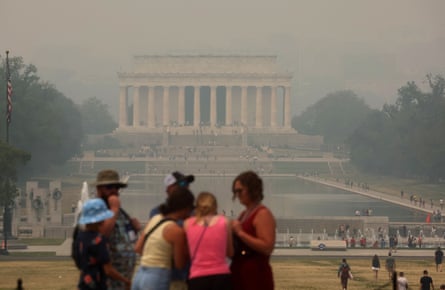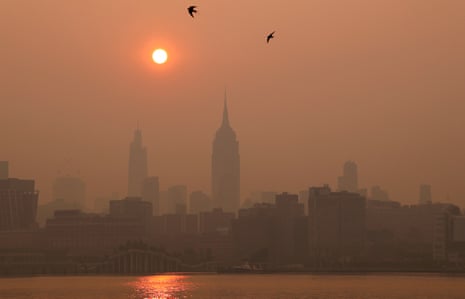The unnerving sight of New York City’s skies turning a dystopian orange from wildfire smoke is just the latest in a barrage of recent distress signals that life in the US is starting to fray under the relentless pressure of the climate crisis, experts have warned.
On Wednesday, New York held the dubious title of having the worst air quality in the world, with Detroit in second place, as plumes of smoke from hundreds of fires in Ontario and Quebec were carried south by a stiff breeze.
Toxic air warnings affected more than 110 million Americans across a dozen states as a sort of demonic tangerine pall engulfed major east coast cities, blotting out everything from the Empire State Building to the Lincoln Memorial.
A meteorologist with the National Weather Service noted that his town in upstate New York “looks like Mars”. It was the worst ever day for wildfire air pollution in recent US history and, as Joe Biden put it, “another stark reminder of the impacts of climate change”.
New Yorkers are not unused to climate-driven disasters, but this felt disturbingly abnormal. Eric Adams, the city’s mayor, said his first reaction to the Blade Runner-like skies was “What the hell is this?” Playgrounds were shut down, Broadway theater actors fled the stage, baseball games were called off and previously discarded pandemic masks were suddenly clamped back on to faces.
“There’s no blueprint or playbook for these type of issues,” Adams admitted. “You want to be as prepared as possible. But there is no planning for an incident like this.”
The climate crisis’s subversion of life’s expected patterns has become a recent theme in the US, however, with the past two weeks showing that global heating is imposing some painful boundaries across the span of the North American continent.
State Farm, the US’s largest insurer, announced it will stop selling new home insurance policies in California, the world’s sixth largest economy, due to the “rapidly growing catastrophe exposure” posed by the state’s increasingly fierce wildfires which, like in Canada, are growing in intensity and size due to the tinderbox-like conditions caused by rising temperatures. A second insurer, Allstate, soon followed suit.

The upending of the housing market in the US west, a region in the grip of a two-decade megadrought worsened by the climate crisis, was then furthered by Arizona’s decision last week to halt new homebuilding in the Phoenix area because it has run out of available groundwater. An era of untrammeled growth into the desert now appears to be ending.
Jesse Keenan, an expert in climate adaptation at Tulane University, said that while progressive voters who throng the US north-east believe the climate emergency is a problem, most hadn’t thought of it as a direct threat to their lives until recently, while those in the west now have to wrestle with a reality far more precarious, and costly, than they once considered.
“The idea of retiring or escaping to sunny weather and living the good life is a fragile dream – nowhere is safe now,” Keenan said.
“There are increasing costs of climate change that will be a lose-lose situation, affecting housing and financial wellness. This will only exacerbate inequalities as those with the best air conditioning and air filtration will do better than those who don’t.
after newsletter promotion
“People always knew living in the US south-west was extremely hard because of the lack of available water, but we had faith in our ability to engineer around Mother Nature,” he added. “That command and control over the environment worked for so long in a stable environment but we are now in an unstable environment. All the infrastructure we relied upon is now failing and there’s no going back.”
Unwelcome climatic news keeps arriving – global greenhouse gas emissions are now at an all-time high, researchers have found, as are the temperatures of the world’s broiling oceans. Adding to this balmy stew is the prospect of a strong El Niño event, with scientists forecasting on Thursday that the periodic phenomenon that heightens global heat will probably strengthen throughout this year. Heatwaves, meanwhile, are scorching everywhere from Siberia to Puerto Rico.
“Climate change isn’t a future problem or a distant one any more,” said Katharine Hayhoe, a climate scientist at the Nature Conservancy. “We’re breathing its impacts directly into our lungs today.”
While most Americans – the largest consumers of energy in the world – aren’t quite yet prepared to give up their hulking SUVs, prodigious meat eating and capacious housing, about two-thirds say they are at least somewhat worried about global heating, according to recent polling by Yale University, and Biden has sold a climate agenda off the feelgood promise of millions of new jobs in renewable energy and electric car manufacturing.
The plummeting cost of wind and solar power, growing uptake of zero-carbon cars and belated government action to tackle the climate crisis mean that “the problems are getting worse and the solutions are getting better,” according to Kate Marvel, a climate scientist at Nasa.
“We live in the best of times and the worst of times,” she said. “We are really seeing climate impacts ramping up, with more fire weather, more floods and stronger storms, but we also have solutions that are increasingly viable. It’s important to hold both of these truths at the same time.”
Marvel said that even while cutting planet-heating emissions to zero won’t result in immediate benefits to the climate, it will quickly lessen the toll of air pollution that regularly affects cities such as Delhi at levels similarly dire to what New York has just experienced.
“If we make the climate better, it will make life better in general,” she said. “We are really starting to see the energy transition happening in the US – it’s not a question of whether it’s going to happen or not, it’s whether it will be fast enough and fair enough. That’s what we’ve still got to work out.”
